Zamioculcas zamiifolia
ZZ plants are charming tropical perennials that have become increasingly popular as houseplants in recent years.
They are incredibly resilient, can do well in low light conditions with little water, and have been known to survive long periods of neglect. If you tend to struggle with keeping houseplants alive, this may be the one for you!
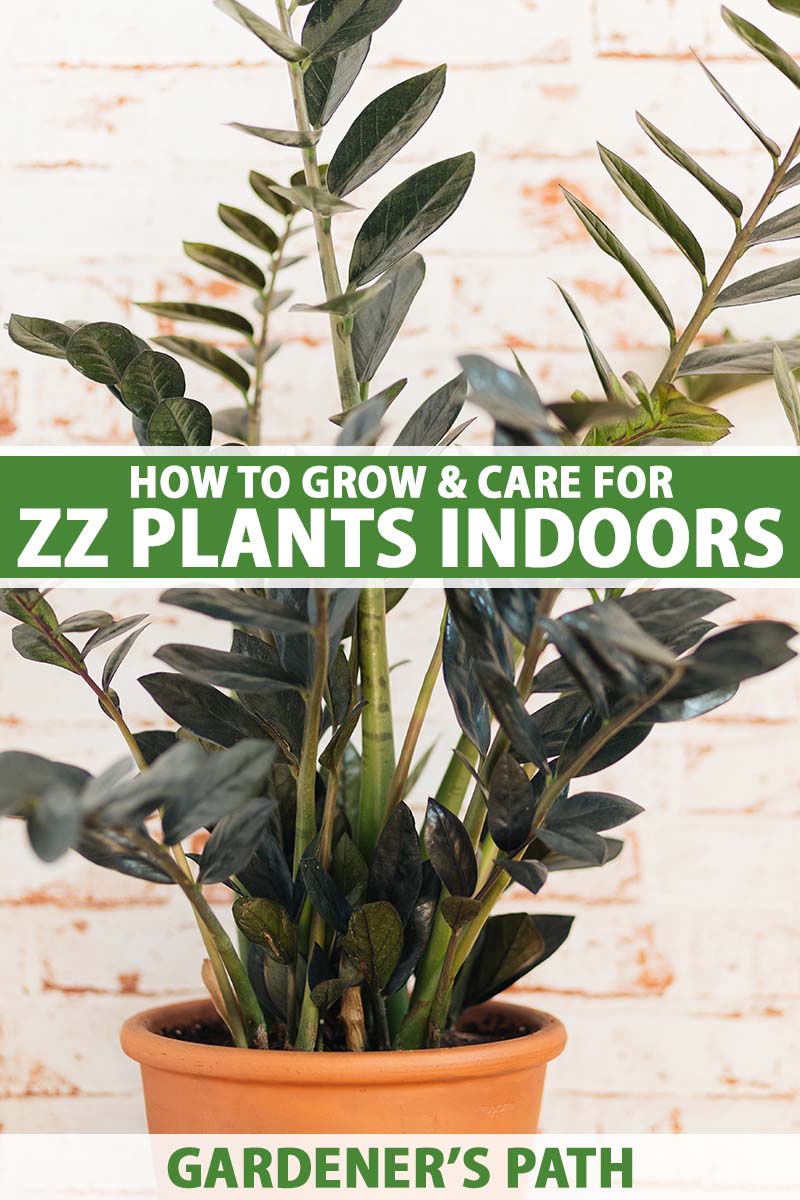
We link to vendors to help you find relevant products. If you buy from one of our links, we may earn a commission.
Continue reading to learn all about growing Z. zamiifolia indoors.
Here’s the lineup:
What You’ll Learn
What Are ZZ Plants?
Zamioculcas zamiifolia, also called Zanzibar gem, aroid palm, zuzu, or ZZ plant, is a tropical perennial with small, waxy, dark green leaves that grow along multiple fleshy stems.
Hardy in USDA Zones 9 and 10, they make fantastic indoor houseplants everywhere else. They can grow as tall as five feet, but typically only reach two or three feet indoors.
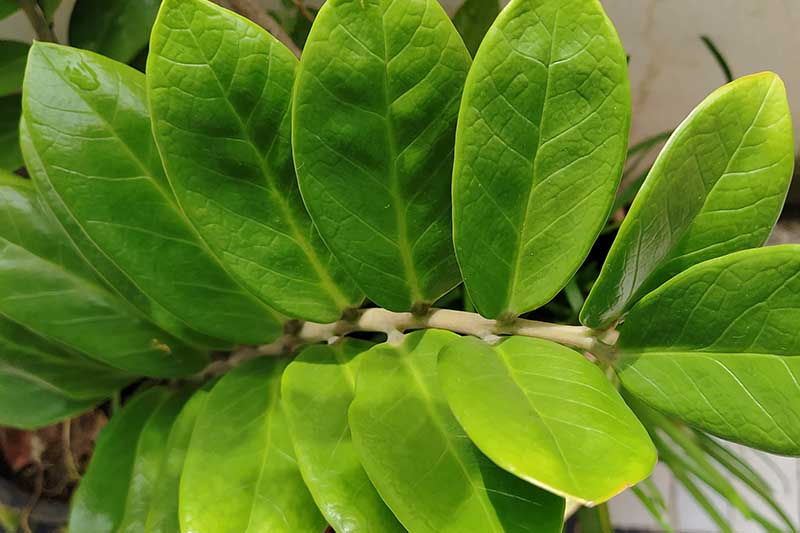
Every part of this plant stores water, from its bulbous underground rhizomes to its fleshy leaves, hence its high tolerance for drought and neglect.
When grown in their native habitat, ZZ plants produce small white spadices protected by green spathes near the base of the stalk that are often hidden by the leaves, similar to what you might see on a peace lily though they are less showy.
But flowering is not typical when these are grown as houseplants.
A Note of Caution:
Zamioculcas zamiifolia contains calcium oxalate crystals which are toxic to cats, dogs, and humans.
Always keep them out of reach of pets and children, and wash your hands after tending plants to avoid any potential skin irritation. It is always a good idea to wear gloves when handling Z. zamiifolia.
Cultivation and History
ZZ plants are native to rocky, arid regions of eastern Africa, from Kenya to northeastern South Africa.
They were originally documented as early as 1829 under the name Caladium zamiifolia, but did not become widespread as ornamentals until the 1990s, when Dutch-owned nurseries in South Africa began global commercial propagation and distribution.

Since they can survive without much care, water, or light, they have become popular in homes, and particularly in offices. You are likely to find these decorating side tables, or in dim corners of office waiting rooms.
ZZ Plant Propagation
ZZ plants are easy, yet slow, to propagate. Rooting cuttings is the preferred method, though it is also possible to divide them if this is done infrequently and sparingly.
From Leaf Cuttings
The best way to start is by rooting leaf cuttings. You can start many at once by taking several of these from a mature stalk.
Plant newly cut leaves in light potting soil in a container with good drainage. Any standard potting mix should work. Water well and set in a location with bright, indirect light.
Continue to water every couple of weeks until rooting occurs, and note that this could take several months. Once the cuttings have rooted, you can repot them individually into larger containers to continue growing.
Read our detailed guide on starting ZZ plants from leaf cuttings for more information.
Division
It is possible to divide Z. zamiifolia, but many gardeners advise against it since the slow-growing rhizomes take a very long time to grow back to full size.

If you do choose to divide them, do so rarely, only once every few years or so.
Before dividing, refrain from watering for a couple of weeks. Then remove the plant from its container and carefully cut or separate a rhizome by hand that has both roots and stems growing from it.
Let wounded plants sit out for a few hours to callus over before replanting each section.
Plant divided rhizomes one inch below the soil line in a loose potting mix, and water thoroughly. Be sure to always choose containers with good drainage.
How to Grow ZZ Plants
These seriously low-maintenance houseplants don’t need much in order to grow. By keeping just a couple of tips in mind, your Zanzibar gem should stay happy for a long time!
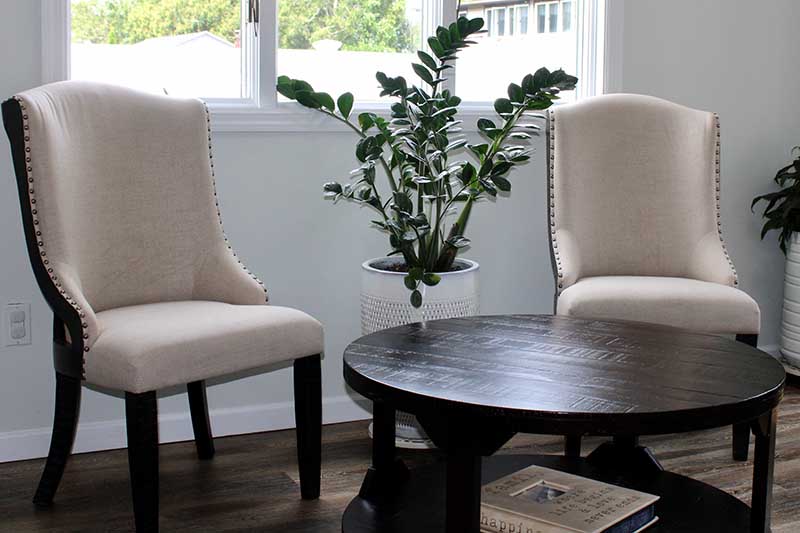
As I already mentioned, Z. zamiifolia can do just fine in low light conditions. They also grow well under fluorescent light, which explains why they do so well in offices.
To provide optimal conditions, it’s best to choose a location that receives bright, indirect light if you can. Always avoid direct sunlight, which could cause the leaves to scorch.
These tropical perennials grow best in temperatures between 60 and 75°F. Exposure to temperatures below 45°F will damage them.
They are also at their best in humid climates though they can tolerate dry air, so avoid placing them in dry areas such as near heat or air conditioning vents.
If the air in your home is especially dry, such as it often is in the winter when the heat is running, some gardeners recommend occasionally misting the foliage with water.
But keep in mind that these plants are prone to rot, so it’s important to avoid being overzealous with the water.
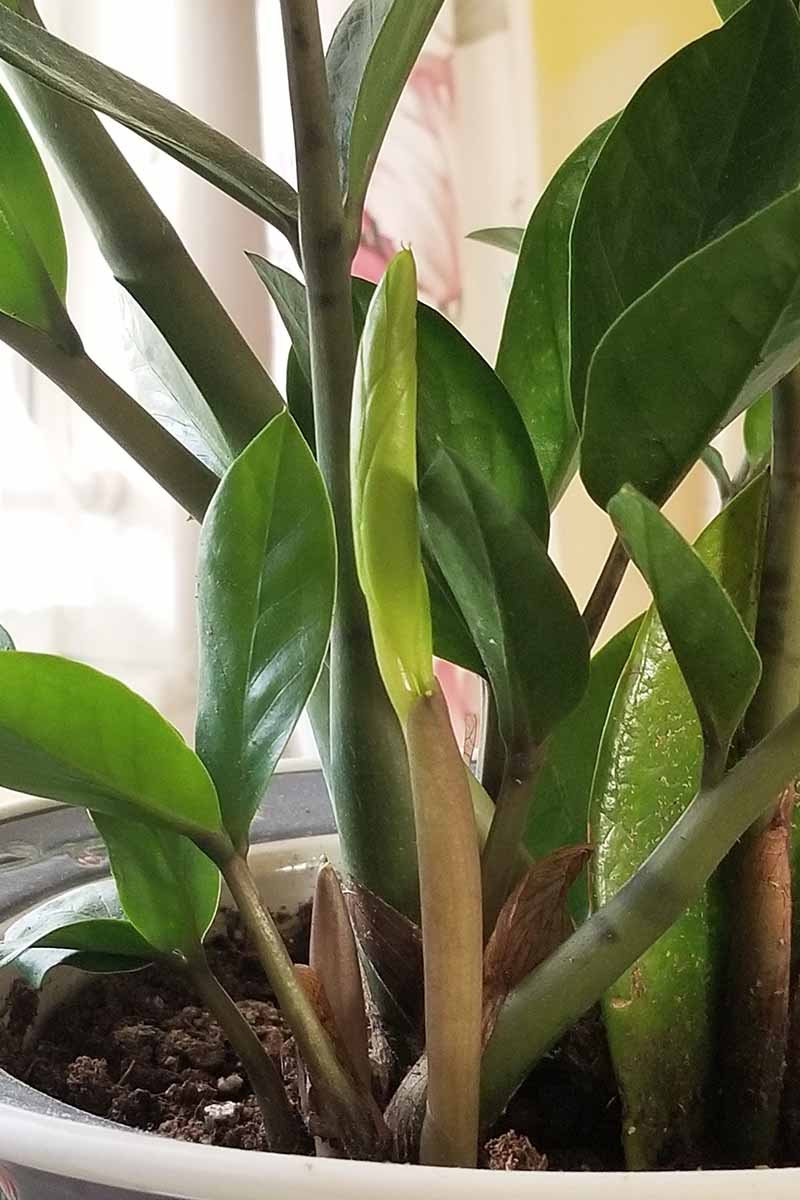
On that note, ZZ only needs to be watered every couple of weeks. The soil should feel dry several inches down between waterings, and the pot will feel lighter when the soil has dried out.
Since too much moisture can lead to root rot and this species can survive months of drought, again, it is better to err on the side of providing less water.
Fertilizer is not really necessary, but if you want to accelerate growth, you can use a diluted liquid organic houseplant fertilizer a couple of times during the growing season (spring through summer) just after watering.
Growing Tips
- Bright indirect light is best. Avoid direct sun.
- Water every couple of weeks, allowing soil to dry thoroughly between waterings.
- Mist foliage occasionally if the environment is dry.
Pruning and Maintenance
While regular maintenance is minimal, it certainly doesn’t hurt to prune every once in a while.
Sometimes, specimens placed in low-light conditions will develop leggy stems as they try to grow towards the light. It is also common for one stem to grow faster than the others, making the plant appear lopsided.
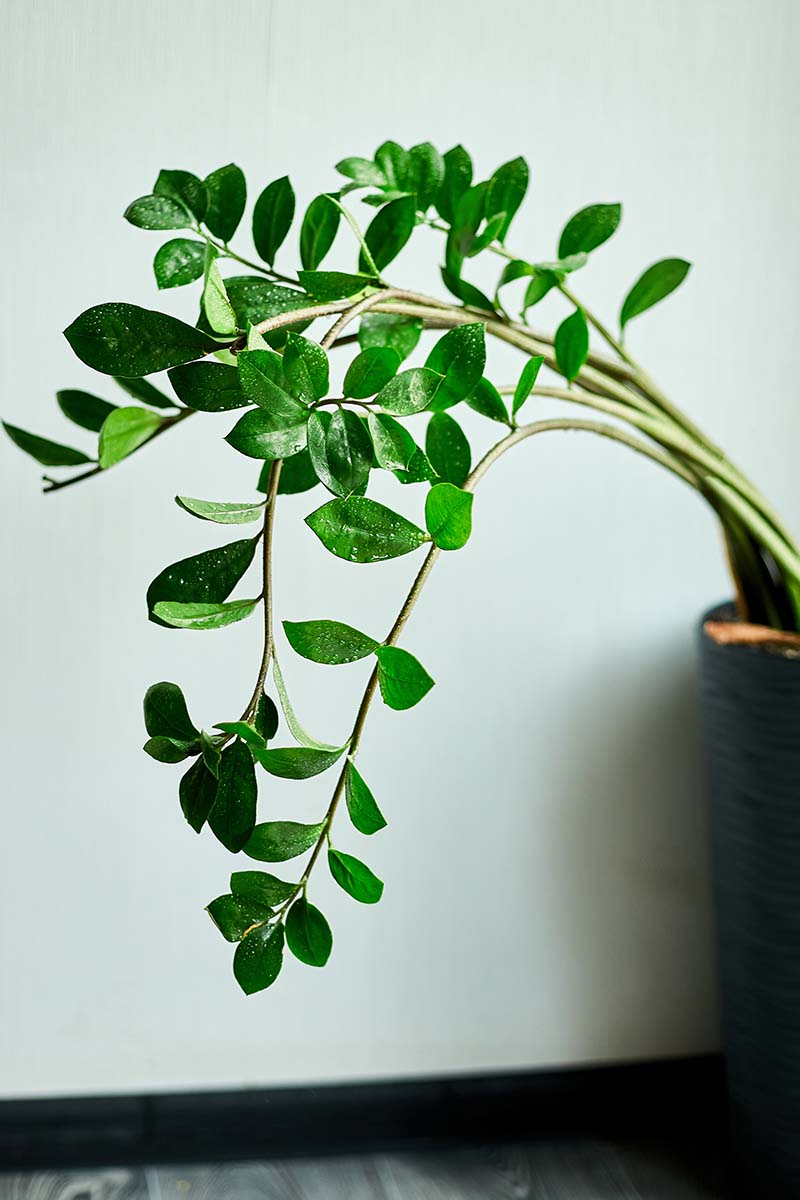
In these cases, you can remove any out-of-place stems to maintain your prefered shape.
You can cut stems back to the height of other stems or all the way down to the soil, whichever you prefer. It is also a good idea to rotate the plants occasionally to provide more balanced light.
Older foliage will eventually turn yellow and fall from the branch. While this is a natural part of the life cycle for this species, you can keep your plants looking fresh by removing old or dead leaves.
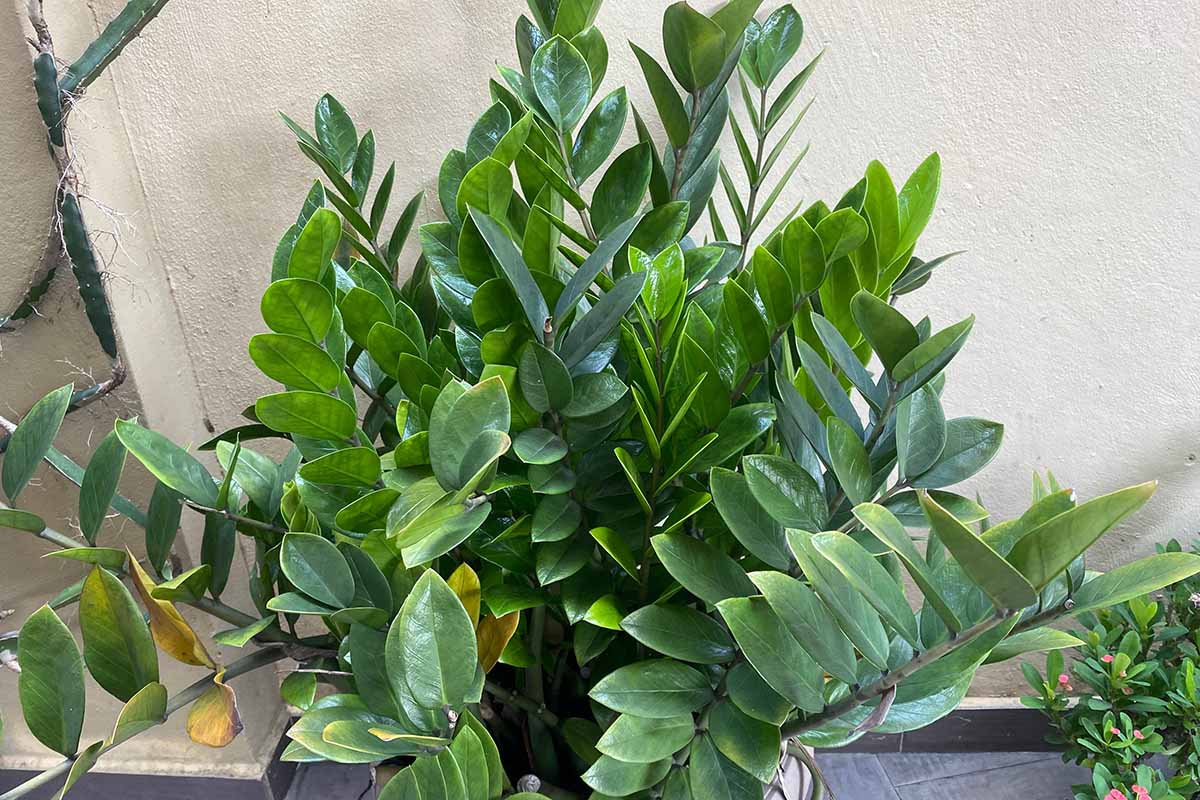
Though ZZ plants rarely fall prey to disease pathogens, if you do notice signs of rot such as soggy stems or leaves, be sure to remove affected parts as soon as you spot them.
When pruning, use sharp, clean scissors and make straight cuts. Always wear gloves or wash your hands after handling ZZ plants.
If a plant seems to be outgrowing its current container, it may also be a good time to repot.
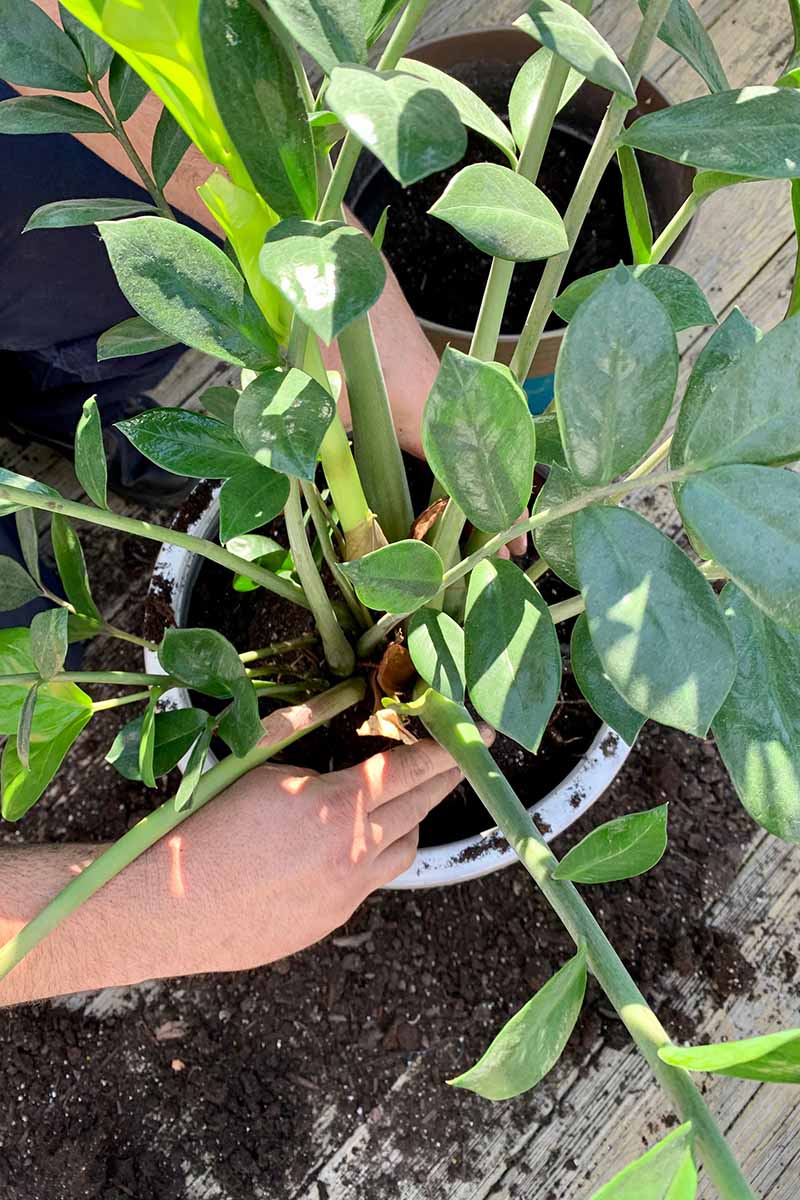
Transfer your ZZ plant to a well-draining container one size up, add new potting medium, and water until it drains from the bottom before placing it back in its usual location.
Cultivars to Select
For the first 20 years of commercial sale, there was really only one type of ZZ plant available.
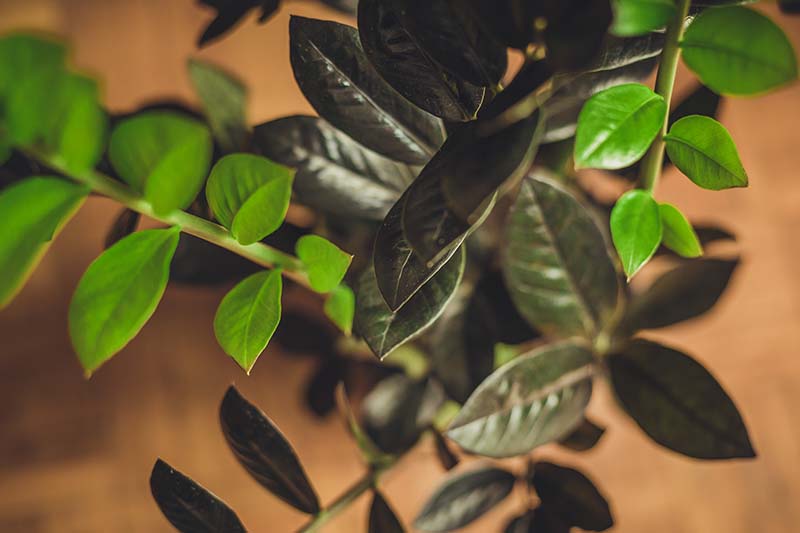
New cultivars are now being developed and becoming more common, but it may take a bit of work to track them down.
The classic ZZ plant with bright, glossy green leaves is easy to find and available for purchase at most nurseries.
You can also find plants online, such as this one in a six-inch container that’s available from Nature Hills Nursery.
Raven™, aka ‘Dowon,’ is a cultivar with leaves that emerge a bright green and deepen to a very dark green or black as they mature.

You may be able to find these at your local nursery or you can purchase potted specimens online, such as this one from Costa Farms that’s available via Amazon in a 12-inch white planter.
You may also come across other more rare varieties such as ‘Zenzi,’ which is a compact cultivar that grows only around a foot tall. It has more tightly grouped leaflets that bunch up near the tops of each stem.
‘Zamicro’ is also more compact than the species plant, with flatter, smaller leaflets. ‘Dark Zamicro’ is similar, but it has leaves that emerge green and darken as they mature. These varieties won’t grow more than two feet tall.
Managing Pests and Disease
These resilient houseplants are very pest resistant, and rarely suffer from disease.
It is possible for aphids to damage foliage, especially if you put them outside during the summer. Though the aphids themselves are hard to see, you might notice yellow spotting on the leaves to indicate their presence.
You can remove them by wiping the leaves off with mild dish soap and water.
In terms of disease, the main issue to watch out for is root rot. Waterlogged soil encourages fungal growth, which can lead to rot in the roots and stems.
Signs of a problem include discolored leaves; weak, falling, or mushy stalks; and an unpleasant odor coming from the soil.
Caused primarily by overwatering, root rot can be prevented easily by planting in a well-draining container, and watering only when the soil is dry to the touch.
In the early stages of rot, you can remove the plant from its container and try repotting it in new soil.
Before replanting, examine the roots and cut off those that show signs of rotting. For the first few days after replanting, keep the soil lightly but evenly moist, then return to watering only when the soil is dry.
Quick Reference Growing Guide
| Plant Type: | Tropical evergreen perennial | Flower/Foliage Color: | White (rare indoors)/dark green |
| Native to: | Eastern Africa | Maintenance: | Low |
| Hardiness (USDA Zone): | 9-11 (outdoors) | Tolerance: | Drought, low light |
| Bloom Time: | Spring (rare for houseplants) | Soil Type: | Porous potting mix |
| Exposure: | Bright-low indirect light | Soil pH: | 6.0-7.0 |
| Time to Maturity: | 3-5 years | Soil Drainage: | Well-draining |
| Planting Depth: | Depth of the root ball | Water Needs: | Low |
| Height: | 3-5 feet | Family: | Araceae |
| Spread: | 2 feet | Genus: | Zamioculcas |
| Common Pests and Disease: | Aphids; Root rot | Species: | Zamiifolia |
An Almost Unkillable Plant
Whether you are a beginner gardener, have a low-light space that could use some color, or are simply too busy to devote a lot of time to houseplants, Zamioculcas zamiifolia will make a good fit.
This “unkillable” plant is attractive, unique, and sure to brighten up any corner!
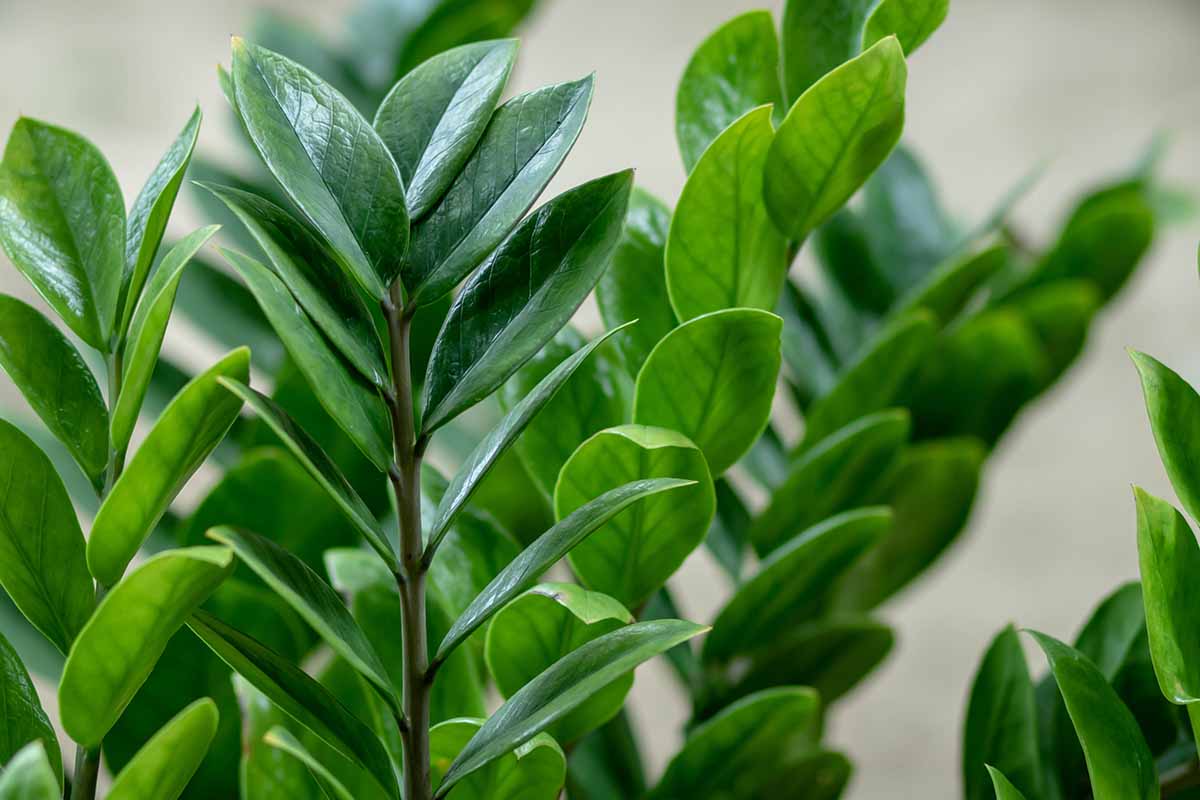
Do you have experience growing ZZ plants? Share your tips in the comments below!
Want to learn more about growing tropical houseplants? Check out these articles next:
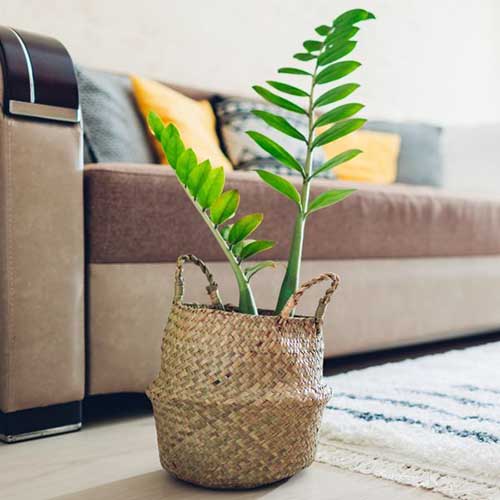
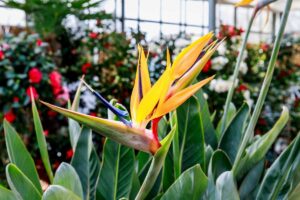

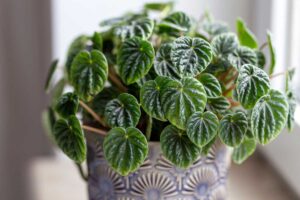
For three years, my ZZ has done spectacularly well next to a window with moderate light. I water it weekly only because it sits next to a wall heating & A/C unit which dries the soil out quickly. There is one area that has produced one stem of new growth that was strange. I cut it back. I cut it open and found something black though I don’t recall much else. It wasn’t mushy, oozy, or otherwise concerning in texture or smell. Another such new growth has returned. There are no visible pests in the soil or on the leaves.… Read more »
Hi Rose, congrats! Your plant is very, very happy! That growth is the beginning of a flower, which is fairly rare on indoor plants. You can prune the whole thing off or let it flower and then remove it once it fades. Enjoy it and keep doing what you’re doing because it’s working!